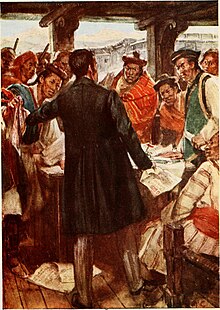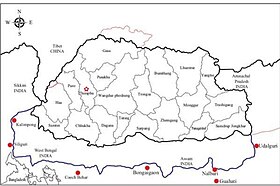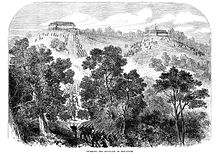| Duar War | |||||||||
|---|---|---|---|---|---|---|---|---|---|
 Ashley Eden forced by the Bhutanese to sign a Treaty, 1864. Illustration by A.D. Macromick (1909) | |||||||||
| |||||||||
| Belligerents | |||||||||
| Bhutan | |||||||||
| Commanders and leaders | |||||||||
|
|
Kagyud Wangchuk (1864) Tshewang Sithub (1865) | ||||||||
The Duar War (or Anglo-Bhutanese War) was a war fought between British India and Bhutan in 1864 to 1865. It has been the only military conflict between the two states since 1774.
Background

Across the nineteenth century, British India commissioned multiple missions to Bhutan. Official documents always cited cross-border raids by Bhutan or sheltering of dissidents as the immediate cause; however, modern historians note Britain's imperialist ambitions in the region to be the actual pretext. Not only was Bhutan a vital cog in the Indo-Tibetan trade but also the commercial viability of Duars region for supporting tea plantations was well known among Company officials.
The most significant of these was a "peace mission" under Ashley Eden in 1863–64, which was dispatched in the wake of a civil war. However, Bhutan rejected the offer and Eden claimed to have been mistreated.
The dzongpon of Punakha – who had emerged victorious – had broken with the central government and set up a rival Druk Desi while the legitimate druk desi sought the protection of the penlop of Paro and was later deposed. The British mission dealt alternately with the rival penlop of Paro and the penlop of Trongsa (the latter acted on behalf of the druk desi).
Battle
| This section needs additional citations for verification. Please help improve this article by adding citations to reliable sources in this section. Unsourced material may be challenged and removed. (November 2023) (Learn how and when to remove this message) |
Britain declared war in November 1864. Bhutan had no regular army, and what forces existed were composed of dzong guards armed with matchlocks, bows and arrows, swords, knives, and catapults. Some of these dzong guards, carrying shields and wearing chainmail armor, engaged the well-equipped British forces.

The fort, known at the time as Dewangiri, at Deothang was dismantled by the British during 1865. The British initially suffered a humiliating defeat at Deothang and when they recaptured Dewangiri they dismantled the fortress there to deny its use to Bhutanese forces.
The Duar War lasted only five months and, despite some battlefield victories by Bhutanese forces which included the capture of two howitzer guns, resulted in the loss of 20% of Bhutan's territory, and forced cession of formerly occupied territories. Under the terms of the Treaty of Sinchula, signed 11 November 1865, Bhutan ceded territories in the Assam Duars and Bengal Duars, as well as the 83 km of territory of Dewangiri in southeastern Bhutan, in return for an annual subsidy of 50,000 rupees. The Treaty of Sinchula stood until 1910, when Bhutan and British India signed the Treaty of Punakha, effective until 1947.
Treaty of Sinchula
| Signed | 11 November 1865 (1865-11-11) |
|---|---|
| Location | Sinchula |
| Effective | 11 November 1865 |
| Condition | Bhutanese cessation of withdrawal of claims to suzerainty of Cooch Behar and the Duars |
| Expiration | 1910 |
| Signatories | Sikkim Political Officer Herbert Bruce; The Druk Desi and his ministers |
| Parties | British India; Bhutan |
| Ratifiers | Viceroy and Governor-General Sir John Lawrence (British India) |
| Language | English |
Below appears the text of the Treaty of Sinchula.
On the 11th day of November, 1865
Treaty between His Excellency the Right Honourable Sir John Lawrence, G.C.B., K.S.I., Viceroy and Governor-General of Her Britannic Majesty's possessions in the East Indies, and the one part by Lieutenant Colonel Herbert Bruce, CB, by virtue of full powers to that effect vested in him by the Viceroy and Governor – General, and on the other part by Samdojey Deb Jimpey and Themseyrensey Donai according to full powers conferred on them by the Dhum and Deb Rajahs, 1865.
ARTICLE I There shall henceforth be perpetual peace and friendship between the British Government and the Government of Bhutan.
ARTICLE II Whereas in consequence of repeated aggressions of the Bhutan Government and of the refusal of that Government to afford satisfaction for those aggressions, and for their insulting treatment of the officers sent by His Excellency the Governor-General in Council for the purpose of procuring an amicable adjustment of differences existing between the two states, the British Government has been compelled to seize by an armed force the whole of the Doars and certain Hill Posts protecting the passes into Bhutan, and whereas the Bhutan Government has now expressed its regret for past misconduct and a desire for the establishment of friendly relations with the British Government, it is hereby agreed that the whole of the tract known as the Eighteen Doars, bordering on the districts of Rungpoor, Cooch Behar, and Assam, together with the Taloo of Ambaree Fallcottah and the Hill territory on the left bank of the Teesta up to such points as may be laid down by the British Commissioner appointed for the purpose is ceded by the Bhutan Government to the British Government forever.
ARTICLE III The Bhutan Government hereby agree to surrender all British subjects, as well as subjects of the Chief of Sikkim and Cooch Behar who are now detained in Bhutan against their will, and to place no impediment in the way of the return of all or any of such persons into British territory.
ARTICLE IV In consideration of the cession by the Bhutan Government of the territories specified in Article II of this Treaty, and of the said Government having expressed its regret for past misconduct, and having hereby engaged for the future to restrain all evil disposed persons from committing crimes within British territory or the territories of the Rajahs of Sikkim and Cooch Behar and to give prompt and full redress for all such crimes which may be committed in defiance of their commands, the British Government agree to make an annual allowance to the Government of Bhutan of a sum not exceeding fifty thousand rupees (Rupees 50,000) to be paid to officers not below the rank of Jungpen, who shall be deputed by the Government of Bhutan to receive the same. And it is further hereby agreed that the payments shall be made as specified below:
On the fulfillment by the Bhutan Government of the conditions of this Treaty Twenty Five Thousand Rupees (Rupees 25,000).
On the 10th January following the 1st payment, thirty five thousand rupees (Rupees 35,000)
On the 10th January following, forty-five thousand rupees (Rupees 45,000)
On every succeeding 10th January, fifty thousand rupees (Rupees 50,000)
See also
References
- ^ Kaul, Nitasha (May 2021). ""Where Is Bhutan?" The Production of Bhutan's Asymmetrical Inbetweenness in Geopolitics". The Journal of Asian Studies. 80 (2): 317–336. doi:10.1017/S0021911820003691. ISSN 0021-9118. S2CID 233908715.
- Political Missions to Bootan (PDF). Calcutta: Bengal Secretariat Office. 1865.
- Rennie, David Field (1866). Bhotan and the story of the Dooar war (PDF). London: John Murray.
- Phuntsho, The History of Bhutan (2013)
- Singh, Nagendra (1978). "Appendix VII – The Treaty of Sinchula". Bhutan: a Kingdom in the Himalayas : a study of the land, its people, and their government (2 ed.). Thomson Press Publication Division. p. 243. Retrieved 25 August 2011.
Bibliography
- Phuntsho, Karma (2013), The History of Bhutan, Random House India, pp. 405–, ISBN 978-81-8400-411-3
- Rennie, Surgeon (1866), Bhotan and the Dooar War, John Murray – via archive.org
| Bhutan articles | |||||
|---|---|---|---|---|---|
| History |  | ||||
| Geography |
| ||||
| Politics | |||||
| Economy | |||||
| Culture |
| ||||
- Conflicts in 1864
- Conflicts in 1865
- Wars involving Bhutan
- Wars involving the United Kingdom
- Wars involving British India
- History of the Bengal Sappers
- 1864 in Bhutan
- 1865 in Bhutan
- 19th-century military history of the United Kingdom
- Military history of Bhutan
- Bhutan–India relations
- Bhutan–United Kingdom military relations
- 1864 in British India
- 1865 in British India